There are numerous types of plankton in Prince William Sound, and their abundance depends on factor such as time of year and oceanographic conditions.
Plankton must over-winter (just like herring), and many emerge in the spring as light levels increase and their phytoplankton food begins to grow. Copepods of the genus Neocalanus, the most common medium-sized zooplankton in the Gulf of Alaska, are a very important prey item for herring.
A key part of work by the Prince William Sound Science Center (PWWSC) is the connection between plankton and herring. Herring stocks in Prince William Sound collapsed dramatically in the years following the Exxon Valdez oil spill. Herring stocks remain at very low levels, and one suggestion is that the amount of food available (including plankton) is at least partially responsible for the lack of recovery. Without sufficient food, herring will more likely to succumb to disease or predation.
In 2007, a plankton monitoring program began in the Sound, supported by a grant from the Exxon Valdez Oil Spill Trustee Council (under the Herring Research and Monitoring Program). Plankton populations were surveyed in the spring (as herring juveniles recover from the winter and also when herring larvae start feeding) and autumn (prior to over-wintering) to monitor populations.
Beginning in 2016, researchers at PWSSC developed a plankton camera with Jules Jaffe and Paul Roberts at the Scripps Institution of Oceanography, with funding from the North Pacific Research Board. The plankton camera was installed on an oceanographic profiler in Prince William Sound from 2016 to 2018, and has collected over 2.5 million images of individual plankters. Work was focused on training computers to identify the plankton in those images to produce very rapid estimates of the abundance of several important plankton types. The results of this work, including the classification accuracy and thresholds, were recently published in the ICES Journal of Marine Science.
To access the article visit: R W Campbell, P L Roberts, J Jaffe, The Prince William Sound Plankton Camera: a profiling in situ observatory of plankton and particulates, ICES Journal of Marine Science, fsaa029, https://doi.org/10.1093/icesjms/fsaa029
You can learn more about the PWSSC plankton monitoring efforts on their website, or listen to this podcast.



